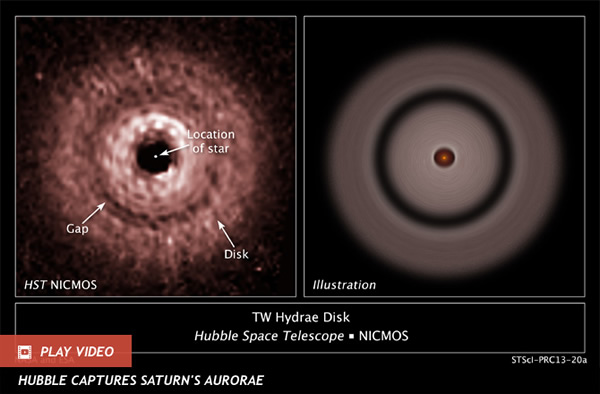Hubble Discovers Far-Out Baby Planet
Hubble Discovers Far-Out Baby Planet
Even by celestial standards, the span between a newly found suspected baby planet and its host star is astronomical — 7.5 billion miles, which is about twice as far as Pluto orbits the sun.
To date, only one other extrasolar planet is farther from its host star as the fledgling world circling TW Hydrae, a small red dwarf located about 176 light-years from Earth. That would be probably be Fomalhaut b, astronomer John Debes, with the Space Telescope Science Institute, wrote in an email to Discovery News.
Scientists are at a loss to explain how the planet, which is believed to be six- to 28 times as big as Earth, could exist.
For starters, the host star is only about 8 million years old, which was believed to be too young to support planets. It also is small, about half as massive as the sun. Computer models show that a planet 7.5 billion miles from its parent star would take 200 times longer to form than a planet positioned about where Jupiter is in our solar system.
Jupiter, which took about 10 million years to form, is around 500 million miles from the sun.
The baby planet was detected indirectly from a telltale gap in a 41-billion-mile wide ring of gas and dust circling TW Hydrae. The gap is believed to be due to the growing planet gravitationally sweeping up material that is then incorporated into the planet.
Astronomers used the Hubble Space Telescope for their survey.
Debes says he and his team were surprised by the finding:
“Our original goal was to simply investigate how the disk changed the brightness of light scattered by dust over different wavelengths. By doing so, one can compare how the brightness changes to different types of dust. We were mainly looking for evidence of water ice. We were aware of previous Hubble studies that had mentioned an unusual shape to how bright the disk was as a function of distance from the star, and early on in our work we decided to see if we could explain that brightness profile as being due to the presence of a gap. We frankly were really surprised at how well the models worked — in our first attempts we got pretty good agreement between our models and the seven separate images we had.”
As to why this particular star caught his eye, Debes had this comment:
“TW Hydrae is one of the best studied young stars with a disk. It has been looked at in nearly every wavelength accessible to astronomers, in a bid to understand its nature as a young star. When a nearly face-on disk was first resolved by John Krist and collaborators it also became a strong focus of people interested in understanding planet-formation. It’s disk is bright relative to the star and pretty large, thus allowing us the best chance of resolving small structures, like this gap, relatively easily.”
The research is published in The Astrophysical Journal.(Jun 14, 2013 01:40 AM ET // by Irene Klotz)












